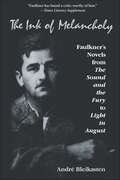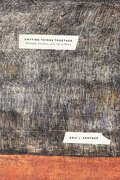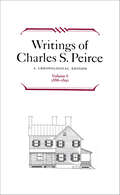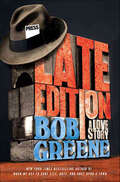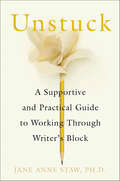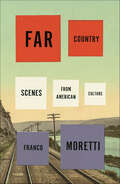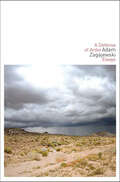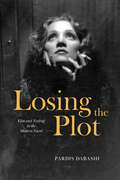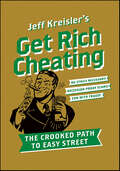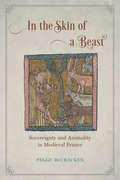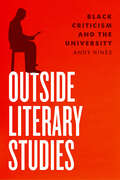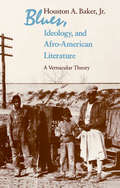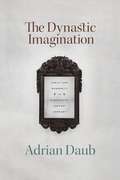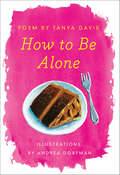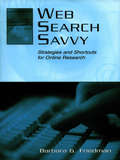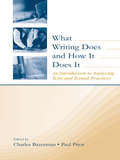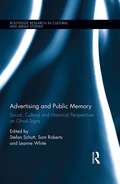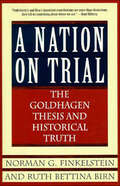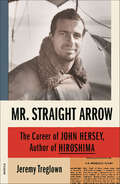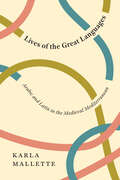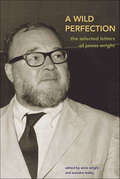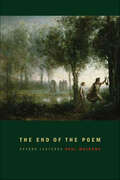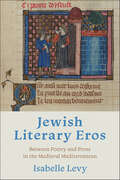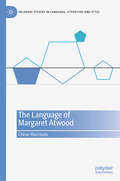- Table View
- List View
The Ink of Melancholy: Faulkner's Novels from The Sound and the Fury to Light in August
by André BleikastenInk of Melancholy re-examines and re-evaluates William Faulkner's work from the late 1920s to the early 1940s, one of his most creative periods. Rather than approach Faulkner's fiction through a prefabricated grid, André Bleikasten concentrates on the texts themselves—on the motivations and circumstances of their composition, on the rich array of their themes, structures, textures, points of emphasis and repetition, as well as their rifts and gaps—while drawing on the resources of philosophy, psychoanalysis, anthropology. Brilliant in its thought and argument, Ink of Melancholy is one of the most insightful and stimulating studies of Faulkner's work.
Untying Things Together: Philosophy, Literature, and a Life in Theory
by Eric L. SantnerUntying Things Together helps to clarify the stakes of the last fifty years of literary and cultural theory by proposing the idea of a sexuality of theory. In 1905, Freud published his Three Essays on the Theory of Sexuality, the book that established the core psychoanalytic thesis that sexuality is central to formations of the unconscious. With this book, Eric L. Santner inverts Freud’s title to take up the sexuality of theory—or, more exactly, the modes of enjoyment to be found in the kinds of critical thinking that, since the 1960s, have laid claim to that ancient word, “theory.” Santner unfolds his argument by tracking his own relationship with this tradition and the ways his intellectual and spiritual development has been informed by it.Untying Things Together is both an intellectual history of major theoretical paradigms and a call for their reexamination and renewal. Revisiting many of the topics he has addressed in previous work, Santner proposes a new way of conceptualizing the eros of thinking, attuned to how our minds and bodies individually and collectively incorporate or “encyst” on a void at the heart of things. Rather than proposing a “return to theory,” Santner’s book simply employs theory as a way of further “(un)tying together” the resources of philosophy, art and literature, theology, psychoanalysis, political thought, and more.
Writings of Charles S. Peirce: A Chronological Edition (Writings of Charles S. Peirce)
by Charles S. PeirceVolume 6 of this landmark edition contains 66 writings mainly from the unsettled period in Peirce's life just after he moved from New York to Milford, Pennsylvania, followed shortly afterward by the death of his mother. The writings in this volume reveal Peirce's powerful mind probing into diverse issues, looking for an underlying unity, but, perhaps, also looking for direction.
Late Edition: A Love Story
by Bob GreeneA loving and laughter-filled trip back to a lost American time when the newspaper business was the happiest game in town.In a warm, affectionate true-life tale, New York Times bestselling author Bob Greene (When We Get to Surf City, Duty, Once Upon a Town) travels back to a place where—when little more than a boy—he had the grand good luck to find himself surrounded by a brotherhood and sisterhood of wayward misfits who, on the mezzanine of a Midwestern building, put out a daily newspaper that didn't even know it had already started to die."In some American cities," Greene writes, "famous journalists at mighty and world-renowned papers changed the course of history with their reporting." But at the Columbus Citizen-Journal, there was a willful rejection of grandeur—these were overworked reporters and snazzy sportswriters, nerve-frazzled editors and insult-spewing photographers, who found pure joy in the fact that, each morning, they awakened to realize: "I get to go down to the paper again."At least that is how it seemed in the eyes of the novice copyboy who saw romance in every grungy pastepot, a symphony in the song of every creaking typewriter. With current-day developments in the American newspaper industry so grim and dreary, Late Edition is a Valentine to an era that was gleefully cocky and seemingly free from care, a wonderful story as bracing and welcome as the sound of a rolled-up paper thumping onto the front stoop just after dawn.
Unstuck: A Supportive and Practical Guide to Working Through Writer's Block
by Jane Anne StawNone of us is immune to writer's block. From well-known novelists to students, associates in business and law firms, and even those who struggle to sit down to write personal correspondence or journal entries -- everyone who writes has experienced either brief moments or longer periods when the words simply won't come. In Unstuck, poet, author and writing coach Jane Anne Staw uncovers the reasons we get blocked - from practical to emotional, and many in between - and offers powerful ways to get writing again. Based on her experiences working with writers as well as her own struggle with writer's block, Staw provides comfort and encouragement, along with effective strategies for working through this common yet vexing problem.Topics include: understanding what's behind the block * handling anxiety and fear * carving out time and space to write * clearing out old beliefs and doubts * techniques to relax and begin * managing your expectations as well as those of family and friends * experimenting with genre, voice, and subject matter * defusing the emotional traps that sabotage progress and success * ending the struggle and regaining confidence and freedom by finding your true voice - and using it. Writers of all levels will find solace, support, and help in this book, leading them to an even deeper connection with their work and more productivity on the page.
Far Country: Scenes from American Culture
by Franco MorettiThe influential and controversial critic takes literary history out of the classroom and into the publicIn the field of literary history and theory, Franco Moretti is synonymous with innovation. The cofounder of the Stanford Literary Lab, he brought quantitative methods into the study of the novel, enabling a “distant” reading that uses computation to analyze literary production over centuries. But at the same time, he was also teaching undergraduates the history of literature. Knowing Moretti, it’s no surprise that he didn’t teach the course the accepted way: one author after another, in a long uninterrupted chain. Instead, he put an irregular chessboard in front of his students that was too strange to be taken for granted. Literary history had become a problem, and he offered a solution.In Far Country, Moretti take these lectures out of the classroom and lets us share in the passion and excitement that comes from radical critique. Unconstrained by genre, Moretti juxtaposes Whitman and Baudelaire, the Western and film noir, even Rembrandt and Warhol, illuminating each through their opposition. With his guidance, we revel in the process of transformation—the earthquakes that shook the “how” of artistic form—and begin to shape a new view on American culture.Bracing in its insight and provocative in its conclusions, Far Country is a critical look at the development of American cultural hegemony.
A Defense of Ardor: Essays
by Adam ZagajewskiArdor, inspiration, the soul, the sublime: Such terms have long since fallen from favor among critics and artists alike. In his new collection of essays, Adam Zagajewski continues his efforts to reclaim for art not just the terms but the scanted spiritual dimension of modern human existence that they stake out. Bringing gravity and grace to his meditations on art, society, and history, Zagajewski wears his erudition lightly, with a disarming blend of modesty and humor. His topics range from autobiography (his first visit to a post-Soviet Lvov after childhood exile; his illicit readings of Nietzsche in Communist Poland); to considerations of artist friends past and present (Zbigniew Herbert, Czeslaw Milosz); to intellectual and psychological portraits of cities he has known, east and west; to a dazzling thumbnail sketch of postwar Polish poetry.Zagajewski gives an account of the place of art in the modern age that distinguishes his self-proclaimed liberal vision from the "right-wing radicalism" of such modernist precursors as Eliot or Yeats. The same mixture of ardor and compassion that marks Zagajewski's distinctive contribution to modern poetry runs throughout this eloquent, engaging collection.
Losing the Plot: Film and Feeling in the Modern Novel
by Pardis DabashiAn examination of the relationship between literature and classical Hollywood cinema reveals a profound longing for plot in modernist fiction. The modernist novel sought to escape what Virginia Woolf called the “tyranny” of plot. Yet even as twentieth-century writers pushed against the constraints of plot-driven Victorian novels, plot kept its hold on them through the influence of another medium: the cinema. Focusing on the novels of Nella Larsen, Djuna Barnes, and William Faulkner—writers known for their affinities and connections to classical Hollywood—Pardis Dabashi links the moviegoing practices of these writers to the tensions between the formal properties of their novels and the characters in them. Even when they did not feature outright happy endings, classical Hollywood films often provided satisfying formal resolutions and promoted normative social and political values. Watching these films, modernist authors were reminded of what they were leaving behind—both formally and in the name of aesthetic experimentalism—by losing the plot.
Get Rich Cheating: The Crooked Path to Easy Street
by Jeff KreislerIn these difficult times, there's only one proven path to ridiculous amounts of money: Cheating. Everyone's doing it—from sleazy CEOs to 'roided-up home run kings, silicone-enhanced starlets, and backroom-dealing congressmen—so why not you? Get Rich Cheating is your definitive guide to the illegal, immoral, and fun, detailing the schemes that have proven time and time again to generate more cash than God, Google, and the Treasury combined. No one ever bought a fleet of Bentleys with hard work, perseverance, and honesty. Simply by purchasing this book, you've already done more than most "ethical" people dare. Open it, savor the moment, and inhale deeply in the musk of your impending wealth—it's time to Get Rich Cheating.
In the Skin of a Beast: Sovereignty and Animality in Medieval France
by Peggy McCrackenIn medieval literature, when humans and animals meet—whether as friends or foes—issues of mastery and submission are often at stake. In the Skin of a Beast shows how the concept of sovereignty comes to the fore in such narratives, reflecting larger concerns about relations of authority and dominion at play in both human-animal and human-human interactions. Peggy McCracken discusses a range of literary texts and images from medieval France, including romances in which animal skins appear in symbolic displays of power, fictional explorations of the wolf’s desire for human domestication, and tales of women and snakes converging in a representation of territorial claims and noble status. These works reveal that the qualities traditionally used to define sovereignty—lineage and gender among them—are in fact mobile and contingent. In medieval literary texts, as McCracken demonstrates, human dominion over animals is a disputed model for sovereign relations among people: it justifies exploitation even as it mandates protection and care, and it depends on reiterations of human-animal difference that paradoxically expose the tenuous nature of human exceptionalism.
Outside Literary Studies: Black Criticism and the University
by Andy HinesA timely reconsideration of the history of the profession, Outside Literary Studies investigates how midcentury Black writers built a critical practice tuned to the struggle against racism and colonialism. This striking contribution to Black literary studies examines the practices of Black writers in the mid-twentieth century to revise our understanding of the institutionalization of literary studies in America. Andy Hines uncovers a vibrant history of interpretive resistance to university-based New Criticism by Black writers of the American left. These include well-known figures such as Langston Hughes and Lorraine Hansberry as well as still underappreciated writers like Melvin B. Tolson and Doxey Wilkerson. In their critical practice, these and other Black writers levied their critique from “outside” venues: behind the closed doors of the Senate Permanent Subcommittee on Investigations, in the classroom at a communist labor school under FBI surveillance, and in a host of journals. From these vantages, Black writers not only called out the racist assumptions of the New Criticism, but also defined Black literary and interpretive practices to support communist and other radical world-making efforts in the mid-twentieth century. Hines’s book thus offers a number of urgent contributions to literary studies: it spotlights a canon of Black literary texts that belong to an important era of anti-racist struggle, and it fills in the pre-history of the rise of Black studies and of ongoing Black dissent against the neoliberal university.
Blues, Ideology, and Afro-American Literature: A Vernacular Theory
by Houston A. Baker Jr.Relating the blues to American social and literary history and to Afro-American expressive culture, Houston A. Baker, Jr., offers the basis for a broader study of American culture at its "vernacular" level. He shows how the "blues voice" and its economic undertones are both central to the American narrative and characteristic of the Afro-American way of telling it.
The Dynastic Imagination: Family and Modernity in Nineteenth-Century Germany
by Adrian DaubAdrian Daub’s The Dynastic Imagination offers an unexpected account of modern German intellectual history through frameworks of family and kinship. Modernity aimed to brush off dynastic, hierarchical authority and to make society anew through the mechanisms of marriage, siblinghood, and love. It was, in other words, centered on the nuclear family. But as Daub shows, the dynastic imagination persisted, in time emerging as a critical stance by which the nuclear family’s conservatism and temporal limits could be exposed. Focusing on the complex interaction between dynasties and national identity-formation in Germany, Daub shows how a lingering preoccupation with dynastic modes of explanation, legitimation, and organization suffused German literature and culture. ? Daub builds this conception of dynasty in a syncretic study of literature, sciences, and the history of ideas, engaging with remnants of dynastic ideology in the work of Richard Wagner, Émile Zola, and Stefan George, and in the work of early feminists and pioneering psychoanalysts. At every stage of cultural progression, Daub reveals how the relation of dynastic to nuclear families inflected modern intellectual history.
How to Be Alone
by Tanya DavisSince its debut on YouTube, Tanya Davis’s beautiful and perceptive poem "How to Be Alone," visually realized by artist and filmmaker Andrea Dorfman, has become an international sensation. In this edition of How to Be Alone, they have adapted the poem and its compelling illustrations for the page in a beautiful, meditative volume—a keepsake to treasure and to share. From a solitary walk in the woods to sitting unaccompanied on a city park bench to eating a meal and even dancing alone, How to Be Alone, reveals the possibilities and joys waiting to be discovered when we engage in activities on our own. As she soothes the disquietude that accompanies the fear of aloneness, and celebrates the power of solitude to change how we see ourselves and the world, Tanya reveals how, removed from the noise and distractions of other lives, we can find acceptance and grace within.For those who have never been by themselves or those who embrace being on their own, How to Be Alone encourages us to recognize and embrace the possibilities of being alone—and reminds us of a universe of joy, peace, and discovery waiting to unfold.
Web Search Savvy: Strategies and Shortcuts for Online Research (Routledge Communication Series)
by Barbara G. FriedmanWeb Search Savvy: Strategies and Shortcuts for Online Research provides readers of all skill levels with efficient search strategies for locating, retrieving, and evaluating information on the Internet. Utilizing her experience as a reporter working on deadline, author Barbara G. Friedman offers the most effective methods for finding useful and trustworthy data online, and presents these techniques in a straightforward, user-friendly manner.Anyone who uses the Internet for research will find much of value here, including techniques that harness the power of advanced searches to optimize search results, avoid advertising clutter, and locate low- or no-cost databases. Screen captures and diagrams illustrate the steps, rationale, and results to accompany various search strategies. This book emphasizes techniques that make the Web work for individuals rather than for advertisers, such as choosing the most appropriate search engine for the job and tweaking its advanced options to narrow a search and optimize results; identifying cost-free sources of online data; using creative approaches to locate information; evaluating the integrity of online data; and protecting the privacy of the researchers and the researched.Web Search Savvy is an essential resource for students, scholars, and practitioners in journalism and mass communications, and it offers practical and useful guidance for anyone researching information online.
What Writing Does and How It Does It: An Introduction to Analyzing Texts and Textual Practices
by Paul Prior Charles BazermanIn What Writing Does and How It Does It, editors Charles Bazerman and Paul Prior offer a sophisticated introduction to methods for understanding, studying, and analyzing texts and writing practices. This volume addresses a variety of approaches to analyzing texts, and considers the processes of writing, exploring textual practices and their contexts, and examining what texts do and how texts mean rather than what they mean. Included are traditional modes of analysis (rhetorical, literary, linguistic), as well as newer modes, such as text and talk, genre and activity analysis, and intertextual analysis. The chapters have been developed to provide answers to a specified set of questions, with each one offering:*a preview of the chapter's content and purpose; *an introduction to basic concepts, referring to key theoretical and research studies in the area;*details on the types of data and questions for which the analysis is best used; *examples from a wide-ranging group of texts, including educational materials, student writing, published literature, and online and electronic media; *one or more applied analyses, with a clear statement of procedures for analysis and illustrations of a particular sample of data; and*a brief summary, suggestions for additional readings, and a set of activities. The side-by-side comparison of methods allows the reader to see the multi-dimensionality of writing, facilitating selection of the best method for a particular research question. The volume contributors are experts from linguistics, communication studies, rhetoric, literary analysis, document design, sociolinguistics, education, ethnography, and cultural psychology, and each utilizes a specific mode of text analysis. With its broad range of methodological examples, What Writing Does and How It Does It is a unique and invaluable resource for advanced undergraduate and graduate students and for researchers in education, composition, ESL and applied linguistics, communication, L1 and L2 learning, print media, and electronic media. It will also be useful in all social sciences and humanities that place importance on texts and textual practices, such as English, writing, and rhetoric.
Advertising and Public Memory: Social, Cultural and Historical Perspectives on Ghost Signs (Routledge Research in Cultural and Media Studies)
by Sam Roberts Leanne White Stefan SchuttThis is the first scholarly collection to examine the social and cultural aspects on the worldwide interest in the faded remains of advertising signage (popularly known as ‘ghost signs’). Contributors to this volume examine the complex relationships between the signs and those who commissioned them, painted them, viewed them and view them today. Topics covered include cultural memory, urban change, modernity and belonging, local history and place-making, the crowd-sourced use of online mobile and social media to document and share digital artefacts, ‘retro’ design and the resurgence in interest in the handmade. The book is international and interdisciplinary, combining academic analysis and critical input from practitioners and researchers in areas such as cultural studies, destination marketing, heritage advertising, design, social history and commercial archaeology.
A Nation on Trial: The Goldhagen Thesis and Historical Truth
by Norman G. Finkelstein Ruth Bettina BirnNo recent work of history has generated as much interest as Daniel Jonah Goldhagen's Hitler's Willing Executioners. Purporting to solve the mystery of the Nazi holocaust, Goldhagen maintains that ordinary Germans were driven by fanatical anti-Semitism to murder the Jews. An immediate national best-seller, the book went on to create an international sensation. Now, in A Nation on Trial, two leading critics challenge Goldhagen's findings and show that his work is not scholarship at all. With compelling cumulative effect, Norman G. Finkelstein meticulously documents Goldhagen's distortions of secondary literature and the internal contradictions of his argument. In a complementary essay, Ruth Bettina Birn juxtaposes Goldhagen's text against the German archives he consulted. The foremost international authority on these archives, Birn conclusively demonstrates that Goldhagen systematically misrepresented their contents. The definitive statement on the Goldhagen phenomenon, this volume is also a cautionary tale on the corruption of scholarship by ideological zealotry.
Mr. Straight Arrow: The Career of John Hersey, Author of Hiroshima
by Jeremy TreglownA monumental reevaluation of the career of John Hersey, the author of HiroshimaFew are the books with as immediate an impact and as enduring a legacy as John Hersey’s Hiroshima. First published as an entire issue of The New Yorker in 1946, it was serialized in newspapers the world over and has never gone out of print. By conveying plainly the experiences of six survivors of the 1945 atomic bombing and its aftermath, Hersey brought to light the magnitude of nuclear war. And in his adoption of novelistic techniques, he prefigured the conventions of New Journalism. But how did Hersey—who was not Japanese, not an eyewitness, not a scientist—come to be the first person to communicate the experience to a global audience?In Mr. Straight Arrow, Jeremy Treglown answers that question and shows that Hiroshima was not an aberration but was emblematic of the author’s lifework. By the time of Hiroshima’s publication, Hersey was already a famed war writer and had won a Pulitzer Prize for Fiction. He continued to publish journalism of immediate and pressing moral concern; his reporting from the Freedom Summer and his exposés of the Detroit riots resonate all too loudly today. But his obsessive doubts over the value of his work never ceased. Mr. Straight Arrow is an intimate, exacting study of the achievements and contradictions of Hersey’s career, which reveals the powers of a writer tirelessly committed to truth and social change.
Lives of the Great Languages: Arabic and Latin in the Medieval Mediterranean
by Karla MalletteThe story of how Latin and Arabic spread across the Mediterranean to create a cosmopolitan world of letters. In this ambitious book, Karla Mallette studies the nature and behaviors of the medieval cosmopolitan languages of learning—classical Arabic and medieval Latin—as they crossed the Mediterranean. Through anecdotes of relationships among writers, compilers, translators, commentators, and copyists, Mallette tells a complex story about the transmission of knowledge in the period before the emergence of a national language system in the late Middle Ages and early modernity. Mallette shows how the elite languages of learning and culture were only tenuously related to the languages of everyday life. These languages took years of study to master, marking the passage from intellectual childhood to maturity. In a coda to the book, Mallette speculates on the afterlife of cosmopolitan languages in the twenty-first century, the perils of monolingualism, and the ethics of language choice. The book offers insight for anyone interested in rethinking linguistic and literary tradition, the transmission of ideas, and cultural expression in an increasingly multilingual world.
A Wild Perfection: The Selected Letters of James Wright
by James WrightThe life and work of a major American poet described in his own words."There is something about the very form and occasion of a letter--the possibility it offers, the chance to be as open and tentative and uncertain as one likes and also the chance to formulate certain ideas, very precisely--if one is lucky in one's thoughts," wrote James Wright, one of the great lyric poets of the last century, in a letter to a friend. A Wild Perfection is a compelling collection that captures the exhilarating and moving correspondence between Wright and his many friends. In letters to fellow poets Donald Hall, Theodore Roethke, Galway Kinnell, James Dickey, Mary Oliver, and Robert Bly, Wright explored subjects from his creative process to his struggles with depression and illness.A bright thread of wit, gallantry, and passion for describing his travels and his beloved natural world runs through these letters, which begin in 1946 in Martin's Ferry, Ohio, the hometown he would memorialize in verse, and end in New York City, where he lived for the last fourteen years of his life. Selected Letters is no less than an epistolary chronicle of a significant part of the midcentury American poetry renaissance, as well as the clearest biographical picture now available of a major American poet.
The Heirs of Anthony Boucher: A History of Mystery Fandom
by Marvin LachmanThe ultimate collection for mystery fansFollowing in the footsteps of those devoted to science fiction and works about Sherlock Holmes, general mystery fandom emerged in 1967 and has since thrived and become an international phenomenon. With its irresistible combination of puzzle-solving and the examination of the dark underbelly of humanity, crime fiction continues to fascinate and delight millions of readers. Ranging the gamut from cozy mysteries to fast-paced thrillers, crime fiction contains a nearly endless range of books… and, of course, a similarly diverse group of readers who devour them.Out of this rabid readership, countless websites, nearly one hundred fan magazines, and dozens of conferences celebrating mysteries have arisen to bring authors, readers, and fans together. This revised and updated edition of The Heirs of Anthony Boucher is an illuminating look at the history of mystery fandom and its effect on readers across the globe. Complete with anecdotes, personal reminiscences, facts, and pictures, it tells the story of the mystery community's publications and conventions, the fans who produce them, and the future of mystery fandom in years to come.
The End of the Poem: Oxford Lectures
by Paul MuldoonIn The End of the Poem, Paul Muldoon, "the most significant English-language poet born since the Second World War" (The Times Literary Supplement), presents engaging, rigorous, and insightful explorations of a diverse group of poems, from Yeats's "All Souls' Night" to Stevie Smith's "I Remember" to Fernando Pessoa's "Autopsychography." Here Muldoon reminds us that the word "poem" comes, via French, from the Latin and Greek: "a thing made or created." He asks: Can a poem ever be a freestanding, discrete structure, or must it always interface with the whole of its author's bibliography—and biography? Muldoon explores the boundlessness, the illimitability, created by influence, what Robert Frost meant when he insisted that "the way to read a poem in prose or verse is in the light of all the other poems ever written." And he writes of the boundaries or borders between writer and reader and the extent to which one determines the role of the other.At the end, Muldoon returns to the most fruitful, and fraught, aspect of the phrase "the end of the poem": the interpretation that centers on the "aim" or "function" of a poem, and the question of whether or not the end of the poem is the beginning of criticism. Irreverent, deeply learned, often funny, and always stimulating, The End of the Poem is a vigorous and accessible approach to looking at poetry anew.
Jewish Literary Eros: Between Poetry and Prose in the Medieval Mediterranean (Sephardi and Mizrahi Studies)
by Isabelle LevyIn Jewish Literary Eros, Isabelle Levy explores the originality and complexity of medieval Jewish writings. Examining medieval prosimetra (texts composed of alternating prose and verse), Levy demonstrates that secular love is the common theme across Arabic, Hebrew, French, and Italian texts. At the crossroads of these spheres of intellectual activity, Jews of the medieval Mediterranean composed texts that combined dominant cultures' literary stylings with biblical Hebrew and other elements from Jewish cultures. Levy explores Jewish authors' treatments of love in prosimetra and finds them creative, complex, and innovative.Jewish Literary Eros compares the mixed-form compositions by Jewish authors of the medieval Mediterranean with their Arabic and European counterparts to find the particular moments of innovation among textual practices by Jewish authors. When viewed in the comparative context of the medieval Mediterranean, the evolving relationship between the mixed form and the theme of love in secular Jewish compositions refines our understanding of the ways in which the Jewish literature of the period negotiates the hermeneutic and theological underpinnings of Islamicate and Christian literary traditions.
The Language of Margaret Atwood (Palgrave Studies in Language, Literature and Style)
by Chloe HarrisonThis book explores Margaret Atwood’s distinctive use of language and style, across a selection of her prose texts, through reader-centred, cognitive stylistic analyses. It examines how strategies of misdirection, processes of doubling, and the creation of textual ambience play an essential role in Atwood’s contemporary prose fiction style. With reference to contemporary scholarship in stylistics and literary criticism, each chapter presents a detailed linguistic analysis of a different text from Atwood’s oeuvre, from Alias Grace (1996) to Old Babes in the Wood (2023). Above all, the book studies experiences of reading Atwood’s works, situating and contextualising her signature linguistic choices in relation to real readers’ responses to her writing. The book should be of interest to readers specialising in the work of Margaret Atwood, including those with stylistics, cognitive linguistics, and literary studies backgrounds.
